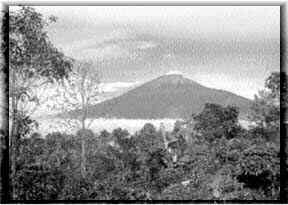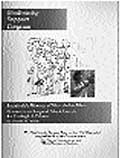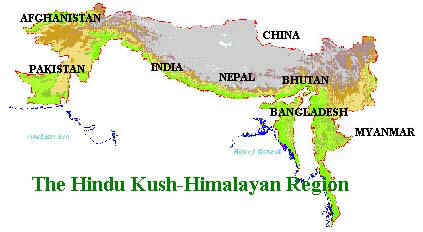People and Plants
Initiative
It
might be a little presumptuous to give
our Initiative such a high profile, but
we thought you would like to know more
about who is responsible for publishing
the handbook. Our series of methods
manuals and working papers will be
featured in coming issues, so you
haven’t heard the last from
us. -GJM
 |
Mount
Kerinci dominates
the northern part
of the Kerinci valley.
The great diversity of
forest types in Kerinci
Seblat National Park is
related to the wide
variation in altitude,
from 300 to 3805m above
sea level (Photos: T.
Thomas).
|
|
The
People and Plants Initiative was
started in July 1992 by the World
Wide Fund for Nature (WWF), the
United Nations Educational,
Scientific and Cultural
Organization (UNESCO) and the
Royal Botanic Gardens, Kew (RBG,
Kew). Through the initiative,
these organizations seek to
promote the conservation of
biodiversity and the sustainable
and equitable use of plant
resources by providing support to
ethnobotanists from developing
countries.
|
|
Field activities concentrate
on biosphere reserves,
World Heritage sites and other
protected areas where the
organizations are active. People
and Plants coordinators offer
training workshops in which
participants gain expertise in
ethnobotanical methods drawn from
various academic disciplines and
discuss ethical issues concerning
the exploitation of botanical
resources in developing
countries. On visits to specific
field projects, the coordinators
assist in developing inventories
of useful plants, documenting
local ecological knowledge and
appraising the impact of
harvesting specific plant
resources in and around protected
areas. Work is carried out
jointly by teams of local people,
park personnel, researchers and
university students as a way of
building local expertise and
reinforcing the interaction
between communities, national
scientific institutions,
non-governmental organizations
and conservation agencies. The
Initiative also provides
participants with scientific and
popular literature, including
working papers and practical
methods manuals on ethnobotany,
resource harvesting and related
topics. |
| |
| These
agroforest gardens are
principally commercial, though
products for home consumption are
also available; the fruits,
leguminous seeds, cloves and
coffee produced are destined for
sale. Timber is kept to meet the
needs of the family but the
surplus may be bought by small
commercial enterprises. In the
understorey, the dead branches
are collected for firewood;
coffee leaves are gathered to
make a very popular drink, kawa.
|
 |
Cinnamon
trees are felled before
the bark is collected
|
|
| These
predominately fruit producing
agoforest systems were probably
the first types of perennial
agroforest systems with a
multi-layered structure
established in Kerinci. According
to oral history, they already
existed at the beginning of the
century when the Dutch arrived in
the region. They are a
farmer’s response to land
constraints and to the
difficulties of managing fragile
soils.’ From:
Aumeeruddy, Y. 1994. Local
Representations and Management of
Agroforests on the Periphery of
Kerinci Seblat National Park,
Sumatra, Indonesia. People and
Plants working paper #3. UNESCO,
Paris.
|
CONTACTS
- Alan
Hamilton, Plants Conservation
Officer, WWF, Panda House,
Weyside Park, Catteshall
Lane, Godalming, Surrey GU7 1XR,
UK; Tel.
+44.1483.426444, Fax
+44.1483.426409
- Pierre
Lasserre, Director,
Division of Ecological
Sciences, Man
and the Biosphere Programme,
UNESCO, 7 place de Fontenoy,
75732 Paris CEDEX 07 SP, France;
Fax +33.1.40659897
- Hew
Prendergast, Centre
for Economic Botany, Royal
Botanic Gardens, Kew, Richmond,
Surrey TW9 3AE, UK;
Tel.
+44.181.3325706, Fax
+44.181.3325278
Back
Biodiversity
Support Program
Janis Alcorn, well known to many
ethnobotanists for her work on Huastec
Maya ethnobotany in Mexico, has been with
the Biodiversity Support Program since
1991. She and other BSP colleagues have
supported numerous projects that focus on
local management of plant and animal
resources.
-GJM
 |
The Biodiversity
Support Program (BSP) was
initiated in 1988 with funding
from the United States Agency for
International Development
(USAID). The program has three
partners, World Wildlife Fund,
The Nature Conservancy and the
World Resources Institute. Its
mission is to promote efforts to
conserve biological diversity
while enhancing human livelihoods
in developing countries, through
improved conservation and use of
biological resources.
|
The Program
seeks to achieve this by analyzing
critical conservation issues and
disseminating the results to field
practitioners, donors, NGOs and others.
The reports which have been produced from
these assessments so far include:
Designing Integrated Conservation and
Development Projects (Michael Brown &
Barbara Wyckoff-Baird, 1992), Sustainable
Harvest of Non-timber Plant Resources in
Tropical Moist Forest: an Ecological
Primer (Charles M. Peters, 1994) and
Conserving Biodiversity in Africa (Jim
Webster, 1994). The BSP has
established the African Biodiversity
Consultative Group, whose members provide
advice on conservation activities within
the continent, and the Biodiversity
Conservation Network (BCN), which
supports projects that use
enterprise-based approaches to
conservation.
‘One of the most basic and
rarely questioned assumptions
underlying much of the current
interest in non-timber tropical
forest resources is that the
commercial harvesting of these
commodities has little or no
ecological impact on a tropical
forest. This ubiquitous idea has
appeared in books, magazines and
newspapers, on television and radio
shows ... and even on the back of
cereal boxes and ice cream cartons.
Unfortunately, this assumption is
both untenable and potentially
dangerous. If intensive resource
extraction is the only activity
planned within a tropical forest,
there is a very high probability that
these resources will be gradually
depleted over time. The basic tenets
of forest ecology tell us this. So
does the long history of forest
exploitation in the tropics.
Regardless of the species, land
tenure or marketing system involved,
collectors cannot simply harvest
commercial quantities of fruits,
nuts, latexes and oil seeds year
after year and then expect the forest
to magically replenish these stocks.
As elsewhere, there is no free lunch
in a tropical forest.’
From:
Peters, C.M. 1994. Sustainable
Harvest of Non-timber Plant Resources
in Tropical Moist Forest: An
Ecological Primer. Biodiversity
Support Program, Washington DC
CONTACTS
Janis
Alcorn, The
Biodiversity Support
Program, c/o
WWF, 1250 24th Street, NW
Washington,
DC 20037, USA; Tel.
+1.202.8618313, Fax
+1.202.8618324
Back
International
Plant Genetic Resources Institute
Pablo
Eyzaguirre, an anthropologist who has
extensive experience in Africa and Latin
America, joined IPGRI in 1995.
He
is responsible for ‘ethnobotany and
human aspects of plant genetic resources
conservation’ within the
Institute’s genetic diversity group.
Among other projects, he is working with
Paul Quek, IPGRI’s documentation and
information specialist, to create a
computerized information system for
recording indigenous knowledge and
ethnobotanical data on plant genetic
resources.
-GJM
The International
Plant Genetic Resources Institute (IPGRI) is an
independent institution of the
Consultative Group on International
Agricultural Research (CGIAR). It is the
successor to the International Board for
Plant Genetic Resources (IBPGR). The
Institute has four major objectives.
First, to assist countries, particularly
in the developing world, in assessing and
meeting their needs for the conservation
of plant genetic resources and to
strengthen links to users of those
resources. Second, to build international
collaboration in the conservation and use
of plant genetic resources, mainly
through the support of networks on both a
crop and a geographical basis. Third, to
develop and promote improved strategies
and technologies for the conservation of
plant genetic resources. Finally, to
provide an information service to inform
the world’s genetic resources
community of both practical and
scientific developments in the field. In
this role, IPGRI produces a range of
publications, including Geneflow and the
quarterly Plant Genetic Resources
Newsletter. IPGRI has its headquarters in
Rome and eight regional offices around
the world.
‘In the past, research has often
ignored bamboo and rattan in favour
of higher value tropical timber. Yet
bamboo and rattan provide diverse
employment opportunities, a myriad of
products, and have more uses than any
... multipurpose tree species in the
world. At least 2.5 billion people
depend on or use bamboo; it has so
many uses - from building material to
food - that it is often called
‘green gold’. Rattan, or
climbing palm, is the source of cane
for furniture and weaving. Together
bamboo and rattan earn global
revenues exceeding US$11 thousand
million. Virtually all rattans and
many bamboos are collected from the
wild. Concerns about overexploitation
and the destruction of tropical
forest habitats have led to more
focused research on bamboo and rattan
use and development. IPGRI, the
International Network for Bamboo and
Rattan (INBAR) and FAO are combining
genetic resources activities with
research on socio-economic and
production aspects.’
From:
Anon. 1994. Keeping Faith with the
Future: Forests and their Genetic
Resources. IPGRI, Rome.
 Agroforests
are economically important for
villagers. In
Sumatra, they provide up to 80%
of village income and
enhance the living standards of
the majority of the households. Agroforests
are economically important for
villagers. In
Sumatra, they provide up to 80%
of village income and
enhance the living standards of
the majority of the households. |
Back
Fauna
and Flora International
FFI is a long established conservation
organization which has recently expanded
its work on plants, and is engaged
in various international initiatives. It
changed its name in June 1995 to reflect
this new orientation.
-ACH
Fauna and
Flora International (FFI), formerly
the Fauna and Flora Preservation Society
- FFPS) was set up in 1903, and today has
members in over 100 countries. The word
flora was added to the society’s
name in 1979, and since then it has
become increasingly involved with
botanical projects. Much of this work
falls within the society’s Species
in Trade Programme. The objective of this
program is to reduce damage to wild
populations of species that are
threatened by trade. It seeks to achieve
this through: promoting cultivation or
alternative methods of sustainable
production; lobbying to regulate, reduce
or eliminate trade; and lobbying for
effective legislation. Botanical projects
within this program are the Indigenous
Propagation Project (IPP), carried out in
collaboration with Dogal Hayati Koruma
Dernegi (DHKD) and WWF; the Salep
Project; Carnivorous Plant Project; and
the Sound Wood Project. Salep is the
Turkish word for a drink made from
orchids, for which there is an extensive
trade in wild-collected plants. FFI is
investigating this trade to try and find
ways to control the collection of
orchids, and to find alternatives from
which to make salep. Similar work is
being conducted on carnivorous plants,
popular plants for horticulture and,
within the Sound Wood Project, on ebonies
and rosewoods, which are highly prized
for making furniture and musical
instruments. The Society’s lobbying
activities are conducted through a
variety of national and international
fora, especially CITES and the Forest
Stewardship Council. FFI also organizes
meetings and provides advice and
information to individuals and other
organizations.
‘Over the last two centuries the
name ‘mahogany’ has been
applied to the wood of possibly as
many as a hundred tree species,
spread over four continents and from
unrelated botanical families.
‘True’ mahoganies are
species from the genus Swietenia and
come from forests of Central and
South America with a seasonal dry
period. They have been given names
such as Brazilian mahogany, Honduras
mahogany and Cuban mahogany depending
on their country of origin.
From the African continent species of
the genus Khaya are also given the
name mahogany, as are species of
Entandrophragma, which are more
accurately known by common names such
as sapele, utile or sipo. From South
East Asia comes a mixture of woods
referred to as Philippine mahogany or
again more accurately by a variety of
different names including lauan and
meranti. They mostly belong to the
genera Shorea and Parashorea. Some
Australian Eucalyptus timber is also
called mahogany ... What all these
timbers have in common is not easy to
see, apart from a tendency to a
reddish colour, straight grain and a
high resin content.’
From:
Read, M. 1990. Mahogany: Forests or
Furniture? FFI, Cambridge.
CONTACTS
- Mike
Read, Fauna
and Flora International,
Great
Eastern House, Tenison
Road, Cambridge
CB1 2DT, UK; Tel.
+44.1223.461471,
Fax
+44.1223.461481
 Every year millions of
cyclamen,snowdrops, snowflakes,
anemones and other bulbs are
harvested from Turkey’s rich
natural bulb fields and exported
to the Netherlands, the centre of
the world’s bulb trade, for
packaging and distribution.
Every year millions of
cyclamen,snowdrops, snowflakes,
anemones and other bulbs are
harvested from Turkey’s rich
natural bulb fields and exported
to the Netherlands, the centre of
the world’s bulb trade, for
packaging and distribution. |
Back
International
Development Research Centre
IDRC has
supported a number of projects on applied
ethnobotany in various developing
countries. Among their recent
publications, books about traditional
environmental knowledge and intellectual
property rights are of particular
interest to ethnobotanists. -GJM
 |
The
International Development
Research Centre (IDRC) is
a public corporation created in
1970 to support technical and
policy research, designed to
adapt science and technology to
the needs of developing
countries. IDRC’s research
programs fall under five core
themes: biodiversity; integration
of environmental, social and
economic policies; food systems
under stress; information and
communication; and technology,
society and the environment.
Within these themes, emphasis is
given to the environmental
dimension of sustainable
development. |
The
Centre provides funding for projects
proposed and managed by developing
country researchers affiliated with
universities, governments and
non-governmental organizations. In this
regard, a pamphlet, How to apply for IDRC
funding, is available that contains
comprehensive guidelines for writing a
research proposal.
Although the Centre’s funds are
provided by the Parliament of Canada,
IDRC’s policies are set by an
international Board of Governors. The
Centre has its Headquarters in Ottawa,
Canada and seven regional offices in
Africa, Asia, Latin America and the
Middle East. IDRC also has a site on the
World Wide Web which contains detailed
information about current
initiatives.
‘The Marovo Project was
initiated by the Marovo people. This
logically influences the approaches
chosen to document traditional
knowledge. For one, it is important
that all scientific work be closely
integrated with ‘local
ways’ so as not to be perceived
as something external to Marovo. A
high degree of local influence over
the research process is taken for
granted by most Marovo people
involved with the Project. This
decisive approach ... has often
evolved into a deep appreciation of a
unique form of close partnership in
research. Marovo villagers show a
preparedness to ‘take
charge’ of the visiting
investigator, not just by providing
food and housing according to
customary hospitality but also by
guiding the day-to-day work of the
visitor, thereby influencing the
research process itself ... (This)
requires the willingness of the
visitor to eat local food, to engage
in conversations on a great variety
of topics, and listen, learn, and
teach.
. ’From:
Baines, G. and E. Hviding. 1992.
Traditional Environmental Knowledge
from the Marovo Area of the Solomon
Islands. Pages 91-110 in Martha
Johnson, editor, Lore: Capturing
Traditional Environmental Knowledge.
IDRC, Ottawa.
CONTACTS
Chusa
Gines, Chief
Scientist for Biodiversity, Programs
Branch, Head Office, IDRC,
PO Box 8500, Ottawa,
Ontario, Canada
K1G 3H9; Tel.
+1.613.2366163, Fax
+1.613.2387230, e-mail
cgines@idrc.ca
Cable RECENTRE OTTAWA, Internet
FTP Server ftp.idrc.ca World
Wide Web site http://www.idrc.ca/
Back
International
Centre for Integrated Mountain
Development
Located in Kathmandu, ICIMOD was
inaugurated in 1983. UNESCO was one of
the four founding sponsors, heralding
more recent cooperation to promote
sustainable and equitable use of plant
resources in the region, through a three
year regional project supported by Danish
funds administered by UNESCO.
-MH

The primary
objectives of the International
Centre for Integrated Mountain
Development are to help
promote economically and environmentally
sound development in mountain ecosystems,
and to improve the living standards of
peoples living in the Hindu
Kush-Himalayas. The countries which fall
within this region are Afghanistan,
Bangladesh, Bhutan, China, India, Myanmar
(Burma), Nepal and Pakistan. ICIMOD
operates as an information network and
resource center, and offers training
opportunities and consultancy services in
resource management. The information
center includes an extensive library,
bibliographic and contacts databases, and
a publications unit. A range of materials
is published by the Centre including
newsletters, discussion papers,
proceedings and workshop reports. ICIMOD
seeks to build capacity in collaborating
institutions through training,
development of facilities and
co-sponsoring activities. The Centre
regularly hosts seminars and conferences
for national, regional and international
audiences. Workshops are an important
part of the Centre’s work for the
exchange of knowledge and experiences in
fields such as community forestry,
rehabilitation of degraded lands and
remote sensing applications for resource
management. Ethnobotany and research into
indigenous knowledge systems are being
further developed with the establishment
in 1995 of a joint program between ICIMOD
and UNESCO.
‘Mountain ecosystems in the
Himalayas have long been neglected
because of their inaccessibility and
economic deprivation. Understanding
how mountain people conceptualise
their ecosystem is particularly
useful when combined with studies of
resource use patterns, appropriation
systems, decision making, and so on.
Basically, the mountain economies of
the region are characterised by
self-sufficient and self-reliant
systems that are agroforestry-based
and have extremely diversified land
use, bioresources and human
cultures’
From:
Shengji, P. 1995. Ethnobotany and
sustainable use of plant resources.
ICIMOD Newsletter 23:7. ICIMOD,
Kathmandu.
CONTACTS
- Egbert
Pelinck or
Pei Shengji, ICIMOD,
PO
Box 3226, Kathmandu, Nepal;
Tel.
+977.1.525313, Fax
+977.1.524509 or 524317,
Telex
2439 ICIMOD NP, e-mail
icimod@mos.com.np
Back
|